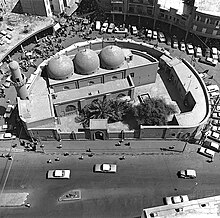Nu'man al-Alusi
Nu'man al-Alusi | |
|---|---|
 A manuscript written and signed by Nu'man al-Alusi, which he dedicated to his teacher Mullah Qasim Effendi. | |
| Personal | |
| Born | Abu al-Barakat Khayr al-Din Nu'man bin Mahmud al-Alusi 1836 |
| Died | 1899 Baghdad, Kingdom of Iraq |
| Resting place | Murjan Mosque, Baghdad, Iraq |
| Religion | Islam |
| Denomination | Sunni Islam |
| Jurisprudence | Independent (with influence from the Hanafi and Shafi'i schools) |
| Creed | Athari |
| Movement | Salafism |
| Occupation | Islamic scholar, jurist and calligrapher |
| Muslim leader | |
Influenced by | |
Influenced | |
Nu'man al-Alusi (Arabic: نعمان الآلوسي, 1836–1899), full name Khayr al-Din Nu'man bin Mahmud al-Alusi, was a 19th-century Iraqi Muslim scholar, jurist and calligrapher.[1][2][3][4] The son of the widely acclaimed Hanafi jurist, Mahmud al-Alusi, Nu'man was born in Baghdad.[1][2][3][4] He later rose to prominence himself as an early supporter of the Salafi movement, which was slowly spreading at the time.[1][2][3][4][5]
Muhammad Bahjat Athari described Nu'man al-Alusi as “Generous, loyal, ascetic, sweet as a fruit, and a forgiving person.”[1][2][3][4] He was also praised by Jamal al-Din al-Qasimi, while he was also credited by Albani in the introduction of his book Sharh al-Ayat al-Bayinat fi Iyadam Sama'i al-Amwat.[3]
Biography[edit]
Nu'man al-Alusi was one of Mahmud al-Alusi's scholarly sons.[1][2][3][4][6] At first, he took knowledge from his own father, but later on as he grew up he became a student of Mullah Qasim Effendi.[2][3][4][6] He served as a qadi (Islamic judge) in several towns, including Hillah.[3][5][6] In the year 1878, Nu'man al-Alusi travelled to Egypt where he studied the works of Siddiq Hasan Khan, a prominent Indian Muslim scholar of the Ahlul Hadith movement.[1][3][7][6] Siddiq Hassan Khan's works were one of those which influenced the ideology and thinking process of Nu'man.[7][6][8] Later in 1882, he migrated to Istanbul, Turkey, but he stayed for two years only.[1][3][4][6] After his stay, he returned to his hometown with the title of Muda'ir al-Madrasa (head teacher).[1][3][4][6]
Nu'man al-Alusi was one of the famous calligraphers of his time, and he took up the hobby of calligraphy from his father.[1][3][4][6] He was fluent in the Rayhani script, and he wrote letters and books in this form.[1][4][3][6] Some of his work is preserved in the archives of the public libraries in Baghdad.[1][3][4][6]

Nu'man al-Alusi died in Baghdad at the age of 63, and he was buried in the grounds of the Murjan Mosque.[1][4][6]
Views and teachings[edit]
Nu'man al-Alusi was one of the early advocates of the Salafi movement.[1][2][4][5][9] However, he also became affiliated with Naqshbandi order of Sufism. His book Jala' al-'Aynayn was intended to serve as a guidebook or manual to the Athari creed, which was conflated with Salafism at the time.[10][11][12] It featured quotes from the Hanbali theologian Ibn Taymiyyah.[13][10][11][12] Siddiq Hasan Khan mistakenly considered Nu'man al-Alusi a Maturidi but his verdict was not well-known or widespread.[13]
Works[edit]
Among his works include;
- Jala' al-'Aynayn fi Muhakamat al-'Ahmadayn
- Al-Ayat al-Bayinat fi Iyadam Sama'i al-Amwat (The Clear Verses on whether the Dead can Hear You)
- 'Akmal al-Kitab al-Hadiqat al-Wurud (The complete book of the Rose Gardens)
- Al-Jawab al-Fasih lima lafaqqahu 'Abd al-Masih (Detailed Response in refutation of 'Abdul-Masih)
See also[edit]
References[edit]
- ^ a b c d e f g h i j k l m التاريخ, تراحم عبر. "نعمان بن محمود بن عبد الله أبي البركات خير الدين الآلوسي". tarajm.com (in Arabic). Retrieved 2024-04-13.
- ^ a b c d e f g "ابن الألوسي - المكتبة الشاملة". shamela.ws. Retrieved 2024-04-13.
- ^ a b c d e f g h i j k l m n "العلامة الأثري النعمان الآلوسي". www.alukah.net (in Arabic). 2007-07-01. Retrieved 2024-04-13.
- ^ a b c d e f g h i j k l m "The biography of Khayr al-Din Nu'man al-Alusi, an Iraqi scholar".
- ^ a b c "ÂLÛSÎ, Nu'mân b. Mahmûd". TDV İslâm Ansiklopedisi (in Turkish). Retrieved 2024-04-13.
- ^ a b c d e f g h i j k "رابطة العلماء السوريين | من عبر التاريخ | حدث في الثاني عشر من المحرم ولادة خير الدين نعمان الآلوسي". islamsyria.com. Retrieved 2024-04-14.
- ^ a b admin (2021-12-12). "Qadi Yusuf al-Nabhani (d. 1932 CE/1350 AH) on the Jala al-Aynayn of Nu'man al-Alusi - Darul Tahqiq". Retrieved 2024-04-13.
- ^ "نعمان بن محمود الألوسي". 1000-islam-final. Retrieved 2024-04-14.
- ^ Ālūsī, Maḥmūd Shukrī (1980). Ghayat Al-amani Fi ʼl-radd ʻala ʼl-Nabhani. Jamiʻat al-ʻUlum al-Athariyya.
- ^ a b Nafi, Basheer M. (2009). "Salafism Revived: Nu'mān al-Alūsī and the Trial of Two Aḥmads". Die Welt des Islams. 49 (1): 49–97. ISSN 0043-2539. JSTOR 27798281.
- ^ a b Haq, Asim ul (2016-09-04). "The praise of the muftis of four Madahib on Jala al Aynayn | Islam". systemoflife.com. Retrieved 2024-04-13.
- ^ a b Cherry-Tech. "الشيخ النعمان الالوسي زاده، رحمه الله، وجهوده في خدمة الدعوة الى الله تعالى ، دراسة تحليلية". المستودع الدعوي الرقمي. Retrieved 2024-04-14.
- ^ a b "Alusi Misquoting Imam al-Munawi on Ibn Taymiyya - Darul Tahqiq". 2021-08-05. Retrieved 2024-04-13.
